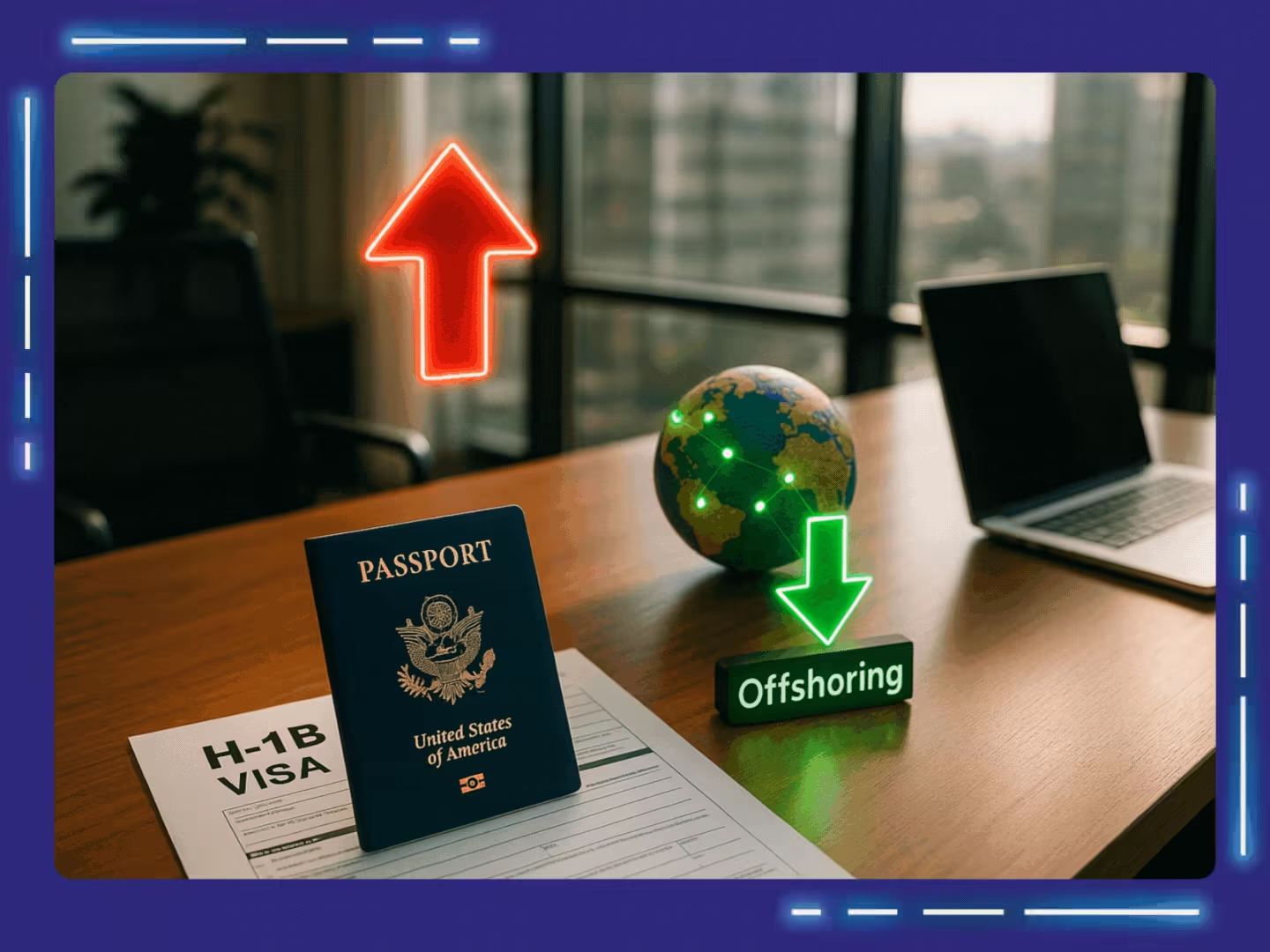In This Blog Post
Share This Article
- Published: Oct 1, 2025
- Last Updated: Oct 13, 2025
- 🔊 Listen
Quick Reads
- The $100,000 H-1B visa fee has created a financial disruption, directly challenging how US companies can afford global skilled talent.
- Economists warn the fee could stifle U.S. productivity and innovation, as historical data shows H-1B workers accounted for 30–50% of US productivity growth between 1990 and 2010.
- The fee will hit smaller firms, startups, and healthcare hardest, potentially worsening the projected shortfall of up to 86,000 doctors by 2036.
- Facing extreme domestic costs, companies now see GCCs and offshoring as the most viable, cost-effective solution for securing top talent.
A financial shockwave just hit the American talent market. The recent surge in H1-B visa fees of $100000 has sparked a heated debate among businesses reliant on foreign talent. As the cost of securing skilled workers through H1-B programs soar, companies are facing tough decisions on how to maintain growth without breaking the bank. As companies look for solutions, offshoring has emerged as a viable option, offering access to top-tier talent at a fraction of the cost.
With reports showing a rise in offshoring adoption across industries, the question arises: could this shift in strategy be the new norm? Let’s find the answers
What exactly is happening with the H1-B Visa Hike?
On September 19, 2025, President Donald Trump issued a proclamation titled “Restriction on Entry of Certain Non-immigrant Workers” that imposes a new $1,00,000 fee on most new H-1B visa petitions filed on or after September 21, 2025.
This fee applies only to new petitions and does not affect extensions, renewals, or those with currently approved visas. It is a one-time payment due upon submitting a new H-1B petition.
Here are some additional key points about the H-1B fee hike:
- The fee aims to curb alleged abuses of the H-1B program and encourage employers to prioritize hiring US workers by significantly increasing costs for hiring new foreign skilled workers.
- The fee only applies prospectively and does not impact petitions filed before 12:01 AM ET on September 21, 2025, or current H-1B visa holders with valid visas.
- New H-1B petitions filed on or after the effective date must include the $1,00,000 payment or risk denial and entry restrictions.
- USCIS, CBP, and DOS have issued clarifications that the fee is limited to new petitions for beneficiaries outside the US and does not restrict current visa holders.
- There has been a 26.9% decrease in the number of eligible registrations for FY 2026 compared to FY 2025.
- The proclamation instructs the Secretary of Labor to review H-1B prevailing wage levels and prioritize higher-skilled, higher-paid individuals in the visa lottery.
- A National Interest Exception process exists for roles, companies, or industries deemed critical to US welfare though eligibility and approval are discretionary and require case-by-case evidence.
- The increase is expected to disproportionately impact startups, smaller employers, and sectors reliant on international medical graduates (IMGs), potentially limiting access to foreign talent.
- Employers and immigrants are facing confusion and uncertainty as regulatory details and implementation procedures continue to evolve.
How does this decision impact US companies?
“JPMorgan economists predict the H-1B visa’s new $100,000 fee could cut 5,500 work authorizations each month, nearly 66,000 a year.”
With thousands of employers relying on these visas, the fee hike is more than a policy shift; it reshapes hiring budgets, innovation, and workforce stability. Smaller firms and nonprofits feel the sharpest strain, while even large companies face compliance and retention risks. Healthcare shortages deepen, and offshoring accelerates. Each consequence is interconnected, showing how these numbers of people, employers, and companies are being directly impacted.
Financial Strain on Employers
The substantial fee is particularly burdensome for startups, mid-sized firms, and non- profits, which may lack the resources to absorb such costs. This financial strain could deter them from hiring highly skilled foreign professionals, potentially stalling innovation and growth. In contrast, large corporations with significant financial reserves might better weather the impact, but even they face challenges in maintaining their workforce and operational efficiency.
Impact on Innovation and Economic Growth
In past cycles, H-1B workers have contributed significantly to innovation and economic performance. Reducing the influx of skilled foreign professionals may stifle innovation and diminish the country competitive edge in global markets.
Employee Morale and Talent Retention
“Nearly 71% of U.S. employers are facing challenges in finding the skilled talent they need.”
The increased fee could also impact the morale of employees currently on H-1B visas. Foreign workers who are already established in the US might consider returning to their home countries or exploring opportunities in countries with more favorable immigration policies, like Canada. This could lead to higher turnover rates and the loss of valuable talent that has already integrated into US workplaces.
Companies that rely heavily on H-1B workers for specialized skills could face increased challenges in retaining their workforce, potentially resulting in a loss of productivity, knowledge, and experience.
Legislative Response and Future Outlook
In response to the visa fee hike, bipartisan lawmakers have reintroduced legislation aimed at reforming the H-1B and L-1 visa programs. The proposed reforms include increasing wage standards, requiring public job postings, and limiting visa eligibility to ensure these programs prioritize American workers and reduce exploitation.
Additionally, the US Commerce Secretary has indicated that significant changes to the H-1B visa process are expected before 2026, signalling ongoing adjustments to the program.
Legal and Operational Uncertainty
Many employers are uncertain about whether the fee applies only to initial H-1B applications or if it also affects visa renewals, extensions, or change-of-employer petitions. This creates a level of ambiguity that complicates workforce planning, as companies are unsure how many of their employees will face additional costs in the future.
Moreover, there are concerns about compliance with the new regulations, leading businesses to consult expensive legal services to ensure they are adhering to the new guidelines.
Impact on Healthcare Services
The healthcare sector, particularly in underserved rural areas, relies heavily on foreign-trained professionals. The new fee could deter hospitals from hiring international medical graduates, exacerbating existing physician shortages. This is particularly concerning given the estimated national shortfall of up to 86,000 physicians by 2036.
Finding a sustainable way forward
Expansion of Global Capability Centers
“A recent Vestian Research study reveals that India accounts for more than 53% of all Global Capability Centres (GCCs) worldwide, highlighting the country’s leading role in their expansion.”
Faced with escalating visa costs, many US firms are accelerating the transfer of operations to countries like the Philippines, China, Mexico or India. India, already home to over 1,700 Global Capability Centers, is witnessing an influx of high-value work in areas such as AI, R&D, and cybersecurity.
Companies like Amazon, Google, JPMorgan, and Walmart are expanding their presence in India, seeking to bypass visa restrictions while maintaining access to skilled labor.
Shift to EOR Solutions
With rising costs and stricter regulations around H1-B visas, businesses are increasingly turning to Employer of Record (EOR) solutions. EOR models allow companies to legally employ talent abroad without the complexities of visas or entity setup. This approach provides a sustainable path to access global talent while maintaining compliance and cost efficiency. For many organisations, EOR is becoming the smarter alternative to navigating H1-B limitations.
Surge in Offshoring and Remote Work
To avoid the high costs associated with H-1B visas, many US companies are turning to remote work and outsourcing. Hiring workers from countries with lower labor costs, like India, China, or Mexico, allows companies to bypass visa fees while securing skilled talent.
The pressure is especially visible in sectors hit hardest by the talent shortage. For instance, in the finance sector, where the shortage of qualified professionals is particularly sharp, businesses are increasingly looking offshore. Offshore accounting services give US firms direct access to highly experienced Chartered Accountants and CPAs from countries like India.
These experts have deep knowledge and experience, giving businesses access to the expertise they need while also saving costs and all without the prohibitive $100,000 price tag attached to the H-1B visa process.
Will offshoring prove to be an effective solution?
Offshoring may not be a one-size-fits-all substitute for onshore talent, but it continues to offer a cost-efficient means of accessing specialized skills without the burden of rising visa expenses. It enables firms to scale effectively, draw on global expertise, and enhance operational resilience.
In the United States, technology companies have long relied on offshore development teams to accelerate innovation and maintain around-the-clock operations. Manufacturers increasingly use offshore design and engineering centers to boost efficiency and reduce production timelines, while healthcare providers outsource administrative and billing functions to improve patient-facing capacity.
Within the financial sector, the growing adoption of accounting outsourcing highlights how offshoring can drive both operational efficiency and sustainable growth. Rising visa expenses may be a short-term concern, but they only reaffirm the enduring importance of offshoring in optimizing cost, capability, and competitiveness across industries.

Get customized plan that supports your growth

Thousands of business owners trust Whiz to manage their account
Let us take care of your books and make this financial year a good one.





